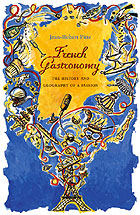Review © 2002 by Burton Kaplan
French Gastronomy: The History and Geography of a Passion
Jean-Robert Pitte
Columbia University Press, New York and Chichester, West Sussex
207pp, hdbk, $24.95, £17.50
ISBN 0-231-12416-3

Fasten your seatbelts, folks. We are headed for some turbulence that’s difficult to confront but impossible to escape.
According to the American Booksellers Association, retail sales of the category of which cookbooks are a part grew about 23 percent between 1991 and 1998 to a record annual level of more than 102 million volumes.
Meanwhile, the National Restaurant Association reports that restaurants now account for an all-time high of 46 cents out of every US food dollar spent away from home, and projects this to reach 53 cents by 2010.
Never, in other words, has so much been published about home cooking yet never has so little cooking been done at home.
The paradox may explain why publishers’ lists seem of late to be less concerned with serious recipes and technique and more focused on tangential subject matter. Notable in this regard are two sorts of successful food-related publishing ventures.
The first is the chef cookbook-cum-memoir phenom. It spawns a virtually limitless supply of the slick pix and words that lead time-hungry readers to engage in culinary wet-dreaming over elaborate preparations they cannot possibly duplicate at home, featuring ingredients they may never be able to find in their local markets.
The second begets a more fulfilling state of affairs. It is the turn intelligent publishers seem to be making toward the more mind-broadening side of things gastronomic–most notably culinary history and anthropology. Volumes of this sort offer unique perspectives on the social and cultural mores of humankind through the ages to give cooks, culinary scholars, and foodies banquets of information on which to feast.
Jean-Robert Pitte’s newish little book (it was first published in French a decade ago) fits neatly into the latter category. While the organizing thesis is the examination of the gastronomy of France through the eyes and palate of a renowned geographer, the shaping influence of earth and climate have very little to do with what makes his book the charmer that it is. No, it is his insatiable appetite for anecdote and little-known fact that illuminate why France became and remains a world center of gourmet culture.
A point established early in his text is that French Catholicism, because it was anything but ascetic, rather good-naturedly contributed to the sensuality for which the French are known. In this regard, perhaps you know (as I did not) that Cardinal de Bernis celebrated mass only with fine Meursault so as "not to make the lord grimace at communion time. In France, nothing is too good for God."
Strasbourg foie gras, to cite another tale, was originated by the Jewish community of Alsace and promoted by Louis XVI to so elevated a national symbol of French cuisine that Tsar Alexander II, dining at Café Anglais, declared he was disappointed not to find it on a Parisian menu.
Potatoes Anna, Pitte recounts, was not a dish invented by Dugléré for a noblewoman but, rather, for a prostitute, Anna Deslions.
Consider also his argument for why France, a notable producer of beer, spirits and wine, is oenocentric. "The bitterness of beer is only acceptable with quite salty or smoked foods; it makes excessively fatty food tolerable. Brandies and liqueurs are useful only for digestion and warmth. Only wines...offer the tastebuds a gustatory palette sufficiently rich to call for analogous foods."
To be sure, France’s peculiar blend of regional climate, soil diversity, natural resources, and a varied topography make their contribution to Pitte’s thinking. And why not? She has some 600 microclimates which allow Mediterranean, Atlantic, and Alpine agriculture to flourish. Her rivers, unlike many in Italy, never dry up, thereby assuring ample freshwater fish to complement coastal catches. The great gastronomic centers of Paris and Lyon came into being because river systems led directly from surrounding farmlands. But, in the end, he demonstrates that haute cuisine is a social phenomenon that owes as much to culinary idiosyncrasy and French wrongheadedness as to weather and soil and things hydrologic. "When the French are polled to determine where people think they can eat best in France," he reports, "Perigord wins a majority of votes. But with regard to starred restaurants, this opinion is perfectly unjustified."
His prose is in the Gallic vein, with its digressions and characteristic asides that leaven the text. Production values, notably intelligent page design and typographic presentation, and quality binding, help make reading effortless.
Good food writing requires appetite and passion as well as serious purpose. Pitte delivers on all counts. The upshot is an amiable book that, better than many, helps explain what makes French food "French."
June 2002




